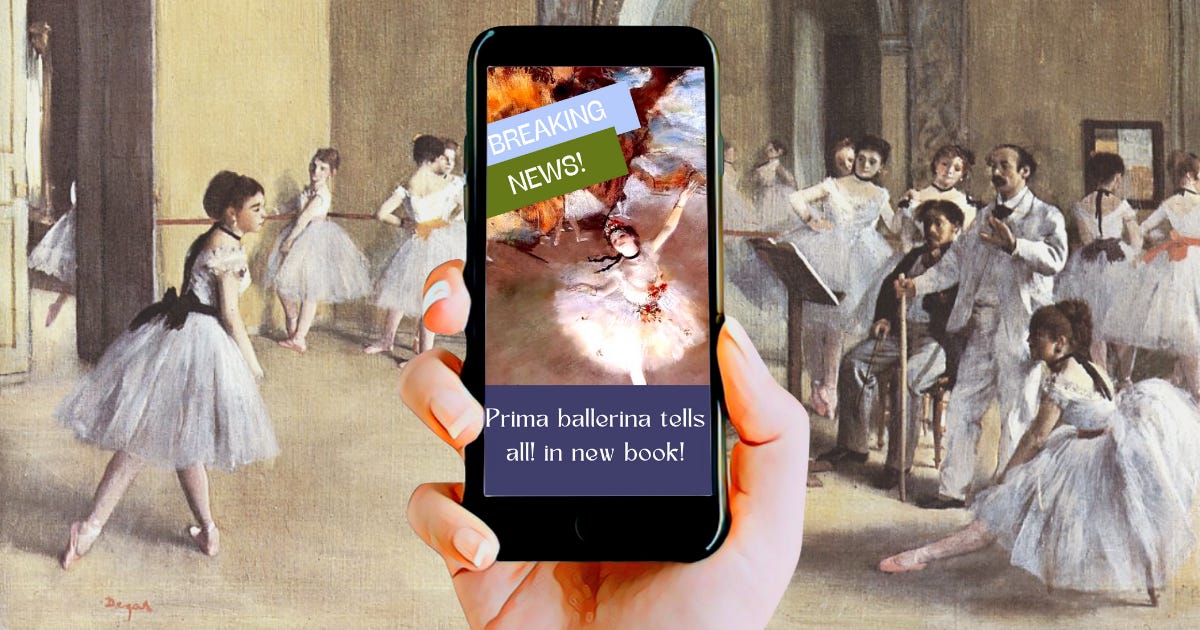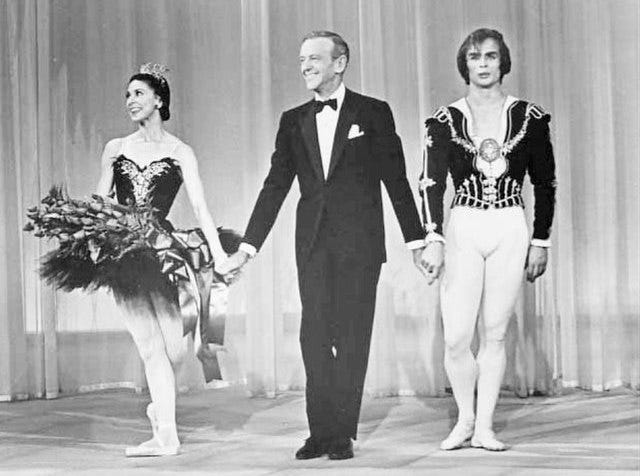Between Ballet and Social Media
When getting sidelined by an injury or losing your job is a blessing in disguise.
I woke up last Monday thinking, “Another week of being a social media manager. Another week of being called Hitler, a Marxist, or a c**t by some anonymous rando on the internet.”
Then I lost my job on Thursday, and I wish I could say I was more upset about it.
I prayed the night before losing my job was to God and for the unsettled parts of my life to fall into place. My life and career were so overwhelming that they never gave me enough time to be alone with my thoughts. It was never quiet enough, still enough, peaceful enough, or restful enough, and the stress was disabling.
Now I’m thinking of the to-do list that vanished into thin air and looking at the personal life in shambles around me, and I actually have time to do things I have put off for a few years…
I can fold my laundry instead of having a clean pile and a dirty pile.
I can go for a walk.
Spend time with my nieces and Facetime my nephews.
Play with my dog.
Visit friends.
Do the dishes piling up in my sink.
Organize—and read—my books.
Start the freelance projects people have been bugging me for.
Do the creative projects I want to do.
I have time to date.
To write.
To reconcile myself with others.
To bury the axe.
To take care of myself.
To sleep.
To pray.
To receive what I actually prayed for.
An Unrequited Love
Being a social media manager is a bit like being a ballerina—it’s a dazzling career from the outside that looks like it comes with tons of cool perks.
Doing social media for 10+ years put me in contact with incredible people: politicians, famous news personalities, authors, Broadway stars, and Grammy-winning musicians, just to name a few. And I absolutely adored it at first. As for dancers, who wouldn’t want to play dress-up and dance to gorgeous music? Both professions are put on a pedestal and admired for being trendy, cool, Instagramable jobs, and both are assumed to make boatloads of money.
In reality, these are low-paying, demanding jobs that take a massive physical, emotional, and mental toll on the poor sap who thought it would be their dream job.
Anyone who has worked in social media will tell you how prone to burnout you are and how overworked and undervalued you can be. Everyone I know who does this professionally has had a similar encounter to the following:
“What do you do for work?”
“I’m a social media manager!”
“Oh, so you just tweet stuff all day?” or “Cute! My 14-year-old niece has a TikTok account too!” or “That seems like a waste of money. Why don’t they put ads in the paper?”
Why is it like this? There are plenty of valid theories, but one that—albeit anecdotally—found to be true is put best by Cornell Professor of Communications Brooke Erin Duffy in an interview she did with Money:
“…companies want applicants to be self-directed AND community-oriented; creative as well as analytic; highly specialized — but also able to “wear multiple hats.” If it seems like employers don’t know what they’re looking for, it’s because they want more than any one employee can give. Their solution? Find people willing to treat their labor like an extension of their life.”
Similarly, long gone are the days when dancers like Darcey Bussell could get plucked out of the crowd by a famous choreographer and become one of the world’s most beloved dancers overnight. Nowadays, most dance companies have unpaid apprenticeship programs. After that, you’ll move on to a non-unionized “second” company that fills in the gaps for the main company. Then, if you’re lucky, you’ll place in the main company’s corps-de-ballet and spend 2-5 years pantomiming in the background before you’re even considered for a promotion to a “first artist” (which is basically a member of the corps-de-ballet with a little more responsibility).
Of course, whether or not you get promoted is subjective. (This is true in both industries). You could try your luck somewhere else and see if another artistic director sees what a magnificent dancer and artist you are, but you will be paying your own way in plane tickets, audition fees, and hotels.
Edgar Degas, the artist who was famous for painting and drawing ballet dancers, was reported to have said:
“And when people talk of the ballet dancers they imagine them as being covered with jewellery [sic] and lavishly maintained with a mansion, carriage and servants, just as it says in story books. In reality most of them are poor girls doing a very demanding job and who find it very difficult to make ends meet.”1
Both ballet and creative careers in marketing and communications can be fun and easy to love at first, but they don’t always love you back.
Overuse Injuries
Like most people who work in social media, I was getting worked down to a nub. My therapist kept telling me to quit my job, my family and friends were worried, and I was seriously searching for a job that had nothing to do with social media.
Similarly, ballet dancers often get burnt out and retire before their mid-thirties—if not earlier. There’s just so much your mind and body can take before it collapses.
Growing up, I was invested in ballet and wanted to become a professional dancer. I idolized the dancers in my local ballet company and kept close tabs on their careers. One of these dancers, Christopher Ruud, started with the company when I was seven years old and finally retired a couple of years ago in 2019—that’s about two decades with the company.
Upon his retirement, he was quoted in The Salt Lake Tribune saying:
“To be perfectly honest, I would do this forever if my body didn’t hurt so much…There is a point — and it’s much longer after you probably should have realized it — at which you can’t do the things you’ve been able to do without even thinking as well as you used to.”
If you’ve been dancing long enough, there’s a point where the list of body parts that don’t hurt is significantly shorter than the list of parts that do. Every now and then, I hear a story through the grapevine about a dancer who is secretly happy when they tear their ACL or twist their ankle because it means they don’t have to put up with the abuse anymore. While I’ve never danced professionally, every time I hear a story like this, I can’t help but think about why I quit pursuing a career in ballet myself.
Becoming a Better Quitter
I’m terrible at quitting. That might sound like a virtue, but it can be a fault when you hold grudges, stay in bad relationships for too long, or bang your head against a wall hoping it will open up a window.
I’ve stayed in two or three jobs way longer than I should have; I stick it out in bad relationships because I convince myself it will get better soon; and it took a suicide attempt for me to finally realize I needed to quit ballet. After I went home from the hospital, my mom set up a meeting with the principal of my ballet conservatory. My parents were worried that ballet had been causing me too much stress and wanted me to quit, and I fought them tooth and nail.
But in that meeting, when the principal asked me if I wanted to continue my studies, I suddenly realized I would be lying to myself (and everyone else) if I said yes. Instead, ballet could be something I could do for fun. I didn’t have to use it as a stick to beat myself with anymore, and it took an incredible burden off my shoulders.
Curtain Call
When people think of the famous Prima Ballerina, Dame Margot Fonteyn, they always think of her spellbinding on-stage chemistry with Rudolph Nureyev. However, people seldom mention how she considered retiring multiple times between the years 1960 and 1979.
The first time she considered retirement, she met Nureyev, sparks flew, and it renewed her passion for dance.
The second time, her politician husband Roberto Arias was shot four times, leaving him a quadriplegic, and forcing her to continue dancing to pay his medical bills. As a result, she was left with very little to support herself by the end of her life.2
Too often, I hang up my figurative pointe shoes after I’m thoroughly overwhelmed by work that has become a chore. Yet, I always wonder how much happier I would be if I left when I was at my peak and moved on to my next adventure before I was forced to retire out of necessity.
Let this be a lesson to always retire on a high note.
From Degas and his Model by Alice Michel. I lifted it from the book Degas by Himself: Drawings, Prints, Paintings, Writings, edited by Richard Kendall.
Luckily for Margot Fonteyn, it paid to be well-connected. When she was dying of ovarian cancer in Panama, everybody who was anybody in British society—including Princess Diana, Princess Margaret, Placido Domingo, and Lord Snowdon—came together for a gala that raised around £250,000 for her end-of-life care. Nevertheless, virtually all her money went to caring for her husband until the end of his life, and she would have been penniless had it not been for all her adoring fans.





